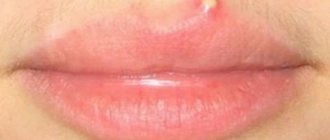To get injured, you don't have to get into fights or engage in extreme sports, just an awkward turn or an accidental fall. Simple bruises and abrasions are quite common; a person becomes familiar with them in childhood, but a cut lip can frighten not only the injured person, but also everyone around him. What to do and how to quickly provide first aid? How can such damage be dangerous?
Causes of injury
In everyday life, lip dissection occurs most often due to negligence or accident. You can trip, fall and hit your face, or find yourself in the path of a stone thrown by someone. Traumatologists note that some of the injuries people receive are the result of curious and incredible coincidences. There was a recorded case where a man went to the emergency room after being attacked by a chicken.
The consequences of a fight, beating or robbery do not belong to domestic injuries, but belong to the sphere of offenses. A split lip may be accompanied by associated injuries that complicate the healing process. Any complicating factor is a strong argument in favor of refusing self-medication and contacting a traumatology department.
Reasons for a swollen lip
Solving the problem of a swollen lip must begin with identifying the cause of the defect. This can best be done (from a professional point of view) by a doctor - dentist, dermatologist, surgeon, traumatologist, therapist. Any of them, based on an examination and anamnesis data, will make a conclusion about the origin of the swelling, but the list of reasons for both the doctor and the layman is approximately the same, the only difference is in the right choice, which is often not possible without specialized education.
So, what can cause a swollen lip? This:
- infectious diseases - both in the oral cavity and in the body as a whole;
- inflammatory processes - both in the oral cavity and in the body as a whole;
- traumatic damage to the mucous membrane, including piercing;
- injury;
- carelessly performed dental procedures;
- allergic reaction;
- herpes.
Correctly determining the reason why the lip is swollen is the basis for taking adequate measures to respond to the problem and solving it as quickly as possible.
First aid and proper damage assessment
A large number of small blood vessels, close proximity to the mucous membrane, a complex muscular structure that provides rich facial expressions - all these factors directly influence the immediate aggravating symptoms that accompany even a slight cut of the lip.
Severe and rapidly worsening swelling and heavy bleeding make it difficult to quickly assess the severity of the injury. Therefore, it is recommended to follow a simple algorithm: if possible, stop the bleeding and wash the wound, apply cold.
Important: an ice compress can be applied for no more than fifteen minutes, after which you must take a break of equal duration.
The main parameters of dissection are the length of the relative red border of the lips and the width of the resulting wound. If the tear extends beyond the red border of the lips, then serious damage to the muscle fibers can be suspected, and a width of more than 7 mm is a clear indication for surgical help.
How to remove a scar on the upper and lower lip
The healing time of the scar depends on the depth and size of the lesion, the presence or absence of inflammation and the state of the immune system. The scarring process is quite long, it can take up to 12 months. In difficult cases, the patient is recommended to resort to the following procedures:
- laser microdermabrasion is a resurfacing procedure that is carried out in several stages. The number of sessions depends on the area of the lesion;
- fractional photothermolysis - stimulation of fibroblasts (builder cells) with a carbon dioxide laser, which stimulates the production of healthy collagen. A course of 2–10 visits is required;
- coagulation - the scar is treated with a special laser to remove the excess number of small vessels. As a result, damaged skin is practically no different in color from healthy skin. The duration of the course is selected individually;
- drug injections - glucocorticoids (hormones) are often used to eliminate keloid and hypertrophic scars; they inhibit excess collagen. Due to this, the skin texture is evened out;
- Permanent makeup is not a method of treatment, but of disguising small scars. It is not suitable for everyone and is only relevant for minor injuries and cuts of the lips.
Please note that these procedures are not suitable for everyone. In particular, getting rid of scars using laser and hormones has a number of contraindications:
- diabetes;
- lactation period;
- pregnancy;
- skin diseases;
- hormonal abnormalities;
- thyroid diseases.
In addition, you will have to stop taking a number of medications, staying in the sun, visiting a sauna or steam bath, and many other usual things.
Traditional methods for treating a scar on the lip
Everyone can find handy products for home use. But traditional medicine recipes are not so effective due to their properties. They can only stimulate blood flow and relieve inflammation in the scar area. They can help with this:
- parsley juice;
- cocoa bean butter;
- honey;
- cinnamon.
You can make lotions from aloe leaves or eucalyptus juice, gruel from finely chopped onions or fresh celery. This will nourish the thin skin of your lips, but unfortunately, it will not prevent scar formation. The effect of such actions is insignificant and hardly noticeable.
In order not to resort to surgical intervention and not to use ineffective folk methods, experts recommend the anti-scar gel Fermenkol for the correction of scars.
A unique complex eliminates both fresh and old scars:
- returns the skin to its original appearance;
- increases the smoothness and elasticity of the skin;
- saves money and does not require expensive procedures;
- safe for children and pregnant women;
- does not contain hormonal components in its composition;
- acts on the problem locally, without affecting healthy tissue.
How to treat a split lip
If the wound needs to be sutured, then it is better not to argue with the doctor on this issue. The fact is that due to the specific location of the injury, healing can be seriously complicated, and it is better to put stitches. As a rule, it is not possible to bring the edges of the wound closer together with a plaster on the lip.
It is better to wash a broken lip with chlorhexidine. Hydrogen peroxide can be used if there is contamination in the wound, in which case the internal tissue may turn white. This is not pus; you should not try to remove the white inclusions formed due to the initial treatment. Zelenka, iodine, and any alcohol solutions are strictly contraindicated; do not aggravate the damage with a burn.
At first, you can cover fresh stitches with a sterile gauze pad and secure them with a band-aid, but in most cases this is not required.
Lip laceration: first aid
Pre-processing is carried out in the following sequence:
- Stop bleeding - cold is applied to the lip, followed by hemostatic agents to reduce bleeding. It is recommended to treat the wound with hydrogen peroxide to prevent inflammation.
- Reassure the person and record the time of the wound formation - if there is a large loss of blood, hemorrhagic and painful shock can occur, so talk to the victim and maintain communication with him before coming to the hospital.
- Reducing pain in the wound - the patient can be given any painkiller (Analgin, Nurofen), which will reduce pain symptoms and improve the general condition.
How to properly freeze a wound on the lip
In the absence of breathing and a threadlike pulse, it is necessary to carry out a series of resuscitation measures aimed at maintaining vital processes in the body. Artificial respiration is performed through the nose, as the wound site may become infected. Indirect cardiac massage allows you to avoid clinical death, but if performed incorrectly, complications can arise.
If the patient is unconscious, place him on his side so that if the wound bleeds, blood does not enter the stomach through the mouth. Severe painful shock can cause vomiting, so lying on your side minimizes the likelihood of vomit entering the respiratory system.
Healing process
In order for treatment to be quick and effective, the specific location of the injury must be taken into account. A healing lip cut is constantly exposed to various influences, because in most cases a person cannot ensure absolute immobility of fresh sutures. The wound is disturbed during conversation or eating, so at least for the first couple of days it is recommended that speech rest and a diet that does not require active chewing movements. This is especially true if the dissection is accompanied by injury to the gums and teeth.
Surgical intervention
Lip wounds with radiating edges require sutures. A local anesthetic is injected into the wound site and the edges are then sutured. The suture is treated with an antiseptic, and then a sterile bandage is applied.
Stitching a wound on the lip
The suture site is checked daily for inflammation. If the healing process is successful, the sutures are removed on the 10th day. Large complex wounds and multiple stitches may require additional assistance from a plastic surgeon.
After suturing, the patient is prescribed medications such as:
After the sutures are removed, the wound is treated with an antiseptic without a sterile dressing. To prevent the development of inflammation in the mouth, rinsing with herbal decoctions, furatsilin and treatment with hydrogen peroxide are recommended.
Stitching outside a medical facility is prohibited. Even with experience, there is a high probability of infection, since it is impossible to achieve infertility at home, which is possible in the operating room.
Child's split lip
If an adult is injured, it is to some extent easier to bear. But at such a moment the child becomes more frightened and may scream, involuntarily aggravating the problem - when screaming, the mouth opens wide, the lips become tense, and the cut receives additional negative effects. Therefore, first of all, the baby needs to be reassured, consoled, and persuaded to be patient.
What to do if a child has a cut lip and is it worth self-medicating? Even if you think it is a minor injury, it is better to consult a doctor. Parents are responsible for the child, and it is better to be safe. It is important to remain calm and confident, because panicking adults only worsen the condition of an already frightened baby.
Otherwise, the treatment process follows the same rules as for adults, except that you should pay closer attention to the cleanliness of the wound, especially in small children.
First aid for cutting
Falling off a swing and hitting your lip and nose is a common occurrence. Soft tissues are easy to break, bite, and as a result they can swell and swell. The main condition when receiving an injury is to remain calm. As soon as the liquid has stopped oozing, you should begin treating the wound.
First aid when a child breaks his lip is to rinse the wound with warm water and treat it with an antiseptic. It is important to wash your face with soap to remove dirt and blood; dirty hands can easily introduce infection into the wound surface. If an injury occurs to a baby, you need to consult a doctor; any injury is dangerous for the child.
If a small amount of blood is released from the wound, you should rinse your mouth with chlorhexidine or miramistine. This is done if the child is an adult. Small children need to lubricate the outside of the lip with a cotton swab. Apply a cold compress (ice or a cold metal object covered with a towel) to relieve swelling. You need to remove the bandage after 15 minutes.
A small piece of bandage or cotton wool pressed between your lips and teeth will help stop blood seepage. It is necessary to ensure that the tampon only absorbs the liquid and does not stick to the wound.
Treating the damaged area with brilliant green or iodine is strictly prohibited to prevent burns.
An effective folk method is to apply cotton wool with aloe juice to the broken area. The plant leaf is cut lengthwise and applied to the wound. Aloe has disinfectant and anti-inflammatory properties, thanks to which you can heal the wound.
You should seek medical help if the bleeding cannot be stopped, the gums are damaged, a tooth is knocked out, or there is a high fever. If the internal cut is large, it will need to be stitched up in the hospital.
Possible misconceptions and complications
Any damage to the face seriously spoils the appearance and attracts unnecessary attention, so all victims are concerned about how long it takes for a cut lip to heal. If there is no inflammation, then after a few days you will notice a significant improvement. The exact timing depends on the severity of the damage.
Getting an infection into the wound aggravates the problem. The inflammatory process begins, the rupture can “turn out”. Redness of surrounding tissues and swelling, accumulation of purulent exudate - if all of the above symptoms are observed, the doctor will prescribe appropriate medications. However, fibrin plaque is taken as a sign of inflammation, which should not be peeled off or washed.
Caring for the wound is actually very simple. You need to try not to disturb the fresh seam, and Levomekol ointment, which has weak antibacterial properties, is perfect for softening. It is not worth drying with alcohol solutions; they can provoke the formation of a rough scab, which, contrary to common misconceptions, does not contribute to a quick recovery.
How to remove swelling after a blow
The affected lip may darken and swell. The following types of damage to the labial border are distinguished:
- Bruise (can be caused by being hit by an object, resulting in internal swelling). The bruise or hematoma will go away within a few weeks.
- An abrasion is a minor tissue injury that does not need to be stitched.
- The wounds appear when the labial border is bitten or cut. The main symptom is a violation of the integrity of the skin. The wound surface may be damaged through and through.
Treatment provides assistance in restoring normal shape and allows the natural color to return. If the lip is swollen from the inside, lotions based on bee honey are useful. The mass is applied to cotton wool and applied to the lower or upper swollen area for 30 minutes.
It is forbidden to apply warm compresses to the wound; the area will swell and swell even more.
Further treatment of the child. Adviсe
After first aid, of course, you should continue to treat the child. During the healing process, the lip will become crusty. You need to make sure that the baby doesn’t chew it. Otherwise, the healing process will be delayed, and it is quite possible that the wound will become infected again.
You also need to lubricate your lip with an emollient. Propolis ointments and honey are suitable for these purposes. If the wound is inside, then rinsing with chamomile will be useful.
Price
The cost of plastic surgery to correct the frenulum of the tongue or lip consists of the cost of a number of dental clinical measures, including: diagnostics (clinical examination of the oral cavity, radiological diagnostic methods, method of surgical correction chosen on the basis of the obtained clinical picture, analysis of the nature of the pathology and the scale of its consequences. Also, the determination of the cost is influenced by the means, equipment and instruments used during the operation, the qualifications of the doctor, and the services of specialized specialists involved in the treatment process if necessary.
Anatomical anomalies of the frenulum of the oral cavity can darken the patient’s life with discomfort, feelings of embarrassment and inferiority. But the problem can be solved with simple surgery. And don’t let this phrase scare you, because plastic surgery of the frenulum of the tongue or lip is a fairly simple and low-traumatic procedure, it is performed using an anesthetic, that is, it is painless, and almost never causes complications. The result - the disappearance of all uncomfortable and painful sensations and the return of self-confidence - is worth it!
According to antiplagiat.ru, the uniqueness of the text as of October 16, 2018 is 99.9%.
Key words, tags: gingivitis, periodontitis, caries, diastema, aesthetic defect, diagnosis, OPTG, periodontal diseases, gum recession, implantation, pulpitis, periodontitis, periostitis, oral examination
*Images: Database of clinical photo protocols of the Professor’s Clinic Edranov 1 https://doctor.by. Encyclopedia of the physical development of the child. Article “Semiotics of congenital and hereditary syndromes” 2 Pediatric surgery: national guidelines. Ed. acad. RAMS Yu.F. Isakova, prof. A.F. Dronova. Moscow, GEOTAR-Media, 2009. 1164 p. 3 Clinical operative maxillofacial surgery. Ed. prof. V.N. Balina, prof. N.M. Alexandrova. St. Petersburg, SpetsLit, 2005, 574 p. 4 Association of lactation consultants “ABC of Motherhood”, St. Petersburg. Article “Ankyloglossia - shortened frenulum of the tongue and upper lip”, Brian Palmer, dental surgeon, Kansas City, USA, 2001) 5 Ed. acad. RAMS Yu.F. Isakova, prof. A.F. Dronova. Moscow, GEOTAR-Media, 2009. 1164 p.
How to prevent hematoma?
Sometimes hematomas on the lip occur even with seemingly insignificant blows to it. In order to reduce this tendency, it is important to strengthen the immune system by eating foods high in vitamin C. Regular use of creams containing this vitamin, which promotes collagen growth and protects blood vessels from damage, would also be helpful. But it is worth remembering that excess vitamin C in the body leads to kidney disease. You need to take vitamin C carefully, remembering that everything is good in moderation.
If the lip is broken and there is swelling on it, you should urgently apply ice to the damaged area. If there is no ice, any chilled object, such as a spoon or a large coin, will do. Cold compresses should not be left on the skin for longer than 15 minutes.
Drug therapy. What drugs are used?
If you have a broken lip and you trust traditional medicine, then the following tips are for you. So what to do in such cases? To relieve swelling, you can use the following medications:
- Bodyaga. It is better to buy it in gel form and rub it in an unlimited number of times throughout the day.
- Ointment "Rescuer". It will improve the overall condition of the lip and also disinfect it.
- Various ointments (Ketonal, Nurofen-gel, Troxevasin and other similar medications).
- Lotions with lead water. The product must be refrigerated before use. Lead water has an analgesic effect. In addition, the product quickly solves the problem of swelling.











